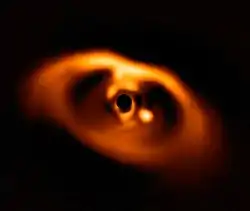Super-Neptune
A super-Neptune is a planet that is more massive than the planet Neptune. These planets are generally described as being around 5–7 times as large as Earth with estimated masses of 20–80 M⊕;[1] beyond this they are generally referred to as gas giants. A planet falling within this mass range may also be referred to as a sub-Saturn.[2]
There have been relatively few discoveries of this kind of planets. The mass gap between Neptune-like and Jupiter-like planets is thought to exist because of "runaway accretion" occurring for protoplanets of more than 20 M⊕—once this mass threshold is crossed, they accumulate much additional mass (due to gravity increasing with mass and the presence of material in an accretion disk) and grow into planets the size of Jupiter or even larger.[2]
Known examples include Kepler-101b, HAT-P-11b, and K2-33b.[3][4]
See also
References
- http://www.space.com/6338-super-neptune-planet.html
- "'Sub-Saturns' May Force Scientists to Revise Idea of How Planets Form". Space.com. 12 January 2019. Retrieved 20 October 2020.
- Bonomo, A. S.; Sozzetti, A.; Lovis, C.; Malavolta, L.; Rice, K.; Buchhave, L. A.; Sasselov, D.; Cameron, A. C.; Latham, D. W.; Molinari, E.; Pepe, F.; Udry, S.; Affer, L.; Charbonneau, D.; Cosentino, R.; Dressing, C. D.; Dumusque, X.; Figueira, P.; Fiorenzano, A. F. M.; Gettel, S.; Harutyunyan, A.; Haywood, R. D.; Horne, K.; Lopez-Morales, M.; Mayor, M.; Micela, G.; Motalebi, F.; Nascimbeni, V.; Phillips, D. F.; Piotto, G.; et al. (2014). "Characterization of the planetary system Kepler-101 with HARPS-N". Astronomy & Astrophysics. 572: A2. arXiv:1409.4592. Bibcode:2014A&A...572A...2B. doi:10.1051/0004-6361/201424617. S2CID 204937746.
- http://phys.org/news/2016-06-young-super-neptune-clues-close-in-exoplanet.html
